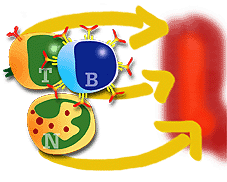| Chapter 6. The cytokines. | | | | | | | How do they activate hematopoiesis and lymphocyte attraction? | Cytokines play a very important role in the stimulation of hematopoiesis of immune cells, acting on immature populations by promoting their maturation and proliferation. Another important activity of the cytokines is the attraction of leucocytes to affected areas. This is one of the defence mechanisms of both the natural and adaptive immune response. Both actions are mediated by different cytokines mainly produced by immune cells, although some are produced by non-immune cells. | | | | |
| Granulocyte-macrophage colony stimulating factor (GM-CSF) |
| Stem cell stimulation factor |
| IL 3 |
| Macrophage colony stimulation factor (M-CSF) |
| IL 7 |
| Erythropoietin (Epo). |
|
Cytokines that stimulate hematopoiesis
The cytokines also belong to a functional group known as hematopoiesis stimulators. Due to the high cell cost of the immune response, a system is needed that allows the number of cells to be rapidly replaced in order to deal with new infections. The cytokines responsible for this task mainly act on immature cells promoting their maturation and proliferation. Many cytokines can perform this important function although the most important are:
|
|

Main cytokines that stimulate hematopoiesis.
Almost all have a structure in the form of monomers of between 19 and 26 kD, with the exception of M-CSF which is a dimer of 40 kD. The majority are produced by macrophages and endothelial cells. Their main function is related to cell proliferation and differentiation, favouring cell maturity.
|
|
| CLASSIFICATION OF CYTOKINE MEMBRANE RECEPTORS |
|
Hematopoietic growth factor receptors. They belong to the a, b and g family of receptors. The following cytokines are included in this group: IL 2, IL 3, IL 4, IL 5, IL 6, IL7, IL 9, IL 13, IL 15, GM-CSF (Granulocyte Macrophage) and G-CSF (Granulocyte colony stimulating factor). |
|
Interferon receptors. They have a and b receptors. They belong to this family: IFNa, IFNb, IFNg. |
Transforming Growth Factor (TGF) receptors. They belong to this family: TGFa and TGFb |
Tumour Necrosis Factor (TNF) receptors. They belong to: (TNFa) and (TNFb). |
Immunoglobulin superfamily receptors. They belong to this family: IL 1a, IL 1b, IL 16.a, IL 1b, IL 16. |
Chemokine receptors (seven part receptors): IL 8, Platelet-Activating Factor (PAF). |
|
Cytokines that stimulate leucocyte attraction
The name chemokines is given to the series of cytokines, more than 15 small proteins (7 a 15 kD), produced by different immune cells (monocyte-macrophage, T lymphocytes) and non-immune cells (fibroblasts and endothelial cells) cells with a strong chemotactic capacity. Their structure is a monomer or dimer of between 7 and 15 kD with membrane receptors characterized by the presence of seven transmembrane domains.
According to their chemical structure and in particular the position of two cysteine residues, these cytokines can be grouped as follows:
|
|
|
CYTOKINES of group a
 |
|
Group a contains cytokines with the capacity to attract neutrophils and lymphocytes but not monocytes. The most important cytosine in this group is IL 8 and PAF (Platelet-activating factor). They are mainly produced by macrophages, lymphocytes, granulocytes, endothelial cells and hepatocytes. |
|
Group b is made up of cytokines with the ability to attract mainly T and B lymphocytes and monocytes and some members of this group can also attract basophils and eosinophils. Macrophage inhibiting proteins (MIP) belong to this group, as do those which attract monocytes (MCP). They are produced by macrophages, T and B lymphocytes and neutrophils. |
|
CYTOKINES of group b
 |
|
CYTOKINES of group g
 |
|
Group g also has the capacity to attract monocytes and lymphocytes; the best-known in this group is lymphotactin. |
|
|
| |

